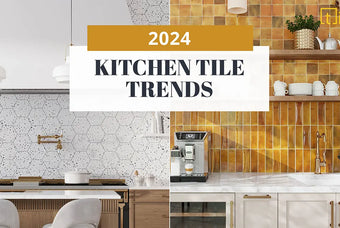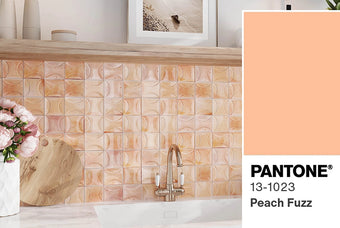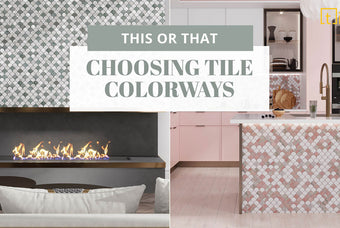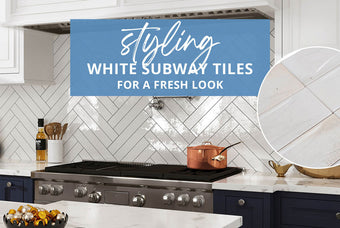Large format tiles are growing in popularity and offer unique advantages for all types of renovations. The bigger the tile size, the more dramatic statement you can make in your home! From easy maintenance of minimal grout lines to their aesthetically pleasing appearance, there are many advantages of large format tiles. (Check out our previous blog!)

Dec.Impact Steel A S-52 (left wall)
Now, it’s important to note that while beautiful, large format tiles can also present its own set of installation challenges. Compared to a standard tile install, large format tiles come with their own specific guidelines in order to avoid installation hurdles. But when we say hurdles, no need to worry! There are just a few things to learn and keep in mind if you want an easier installation. This guide is aimed to give you all the information you need for a trouble-free installation process. So, start reading this guide before you start your project because these tips will help ensure the beauty of your tiles for years to come.
How to install Large Format Tiles
Prepare Your Surface
Obviously, large tiles are heavier than smaller subway or mosaic tiles. That’s why you can imagine that a heavier tile requires stronger substrate. Prior to installation, just as important as having a strong substrate, it’s important to check the substrate flatness to ensure a high quality and quicker installation.
First, verify that your surface meets or exceeds the industry standards and is structurally free of contaminants such as oil, grease, dirt, paint, or other chemicals. Also, check your floor span and the weight of your tiles according to your local building codes. Next, make sure to meet the ANSI (American National Standards Institute) specifications for large format tiles - which recommends that the maximum substrate variation is not more than 1/8” in 10”, and 1/16” in 24” - when measured from surface high points with a straightedge. Any substrate that exceeds the ANSI standards must be fixed with self-leveling underlayment to meet the flatness requirements before installing the tiles.
Not ensuring a flat substrate may create a condition where one edge of the tile is higher than the adjacent one. This will create an uneven and unsightly appearance, as well as a tripping hazard. This is called a lippage.
Pick the Right Adhesive
Next, once you’ve made sure that you have a strong, flat substrate, choosing the right adhesive product for your installation is essential. TCNA (The Tile Council of North America) recommends the use of medium bed mortars when installing large format tiles in order to prevent irregularities in the tile and substrate. Medium bed mortars are designed to be used for heavy, large format tiles that have one side greater than 15”. They form a thicker layer to support the weight of a large format tile compared to regular adhesives (such as thinsets).
Never use thinsets that are used in standard tile installations since thinset shrinks as it dries and can result in uneven surfaces known as "lippage" or cracks for larger tiles. Standard mortars are capable of setting only 3/32” to 3/16” thick bed whereas medium bed mortars provide 3/32” to ¾” thickness, which provides the maximum support and coverage for large tiles. These medium-based mortars, aside from minimizing the amount of shrinking, also allow your large tiles to stay stable, preventing leveling issues between the tiles.
Choose Your Tile Pattern and Offset
Laying out your tiles prior to installation is important. It helps determine the pattern that you like and best suites your project. Besides from the aesthetic perspective, your tile pattern and offset will also affect the chances of a lippage after the install.
Patterns that have the center of one tile near the end of another should be avoided with large tiles using a narrow grout joint. For example, a running bond (brick) pattern is not recommended with large format tiles as any tile that is longer than 15” will tend to have unevenness after installation. Opposed to the traditional ½” brick pattern, it is recommended to use a 1/3” (33%) offset to prevent lippage and cracking with large and heavy tiles. The same risk is present with pinwheel patterns as well. We advise avoiding any patterns with offsets in excess of 1/3", if the tile being used is a large format tile.
Pro Tip: A narrow grout joint is considered to be less than 1/8”. When opting for an offset pattern even with an 1/3” offset, we recommend going with a wider grout joint that is even more than 1/8” for a safer installation.
Determine the Right Grout Joint Width
In general, large format tiles tend to have more lippage and unevenness on the surface, therefore a wider grout joint is necessary to ensure the safety of your tiles. As mentioned above, the pattern plays a big role in grout joints as well.

While a standard 3/16” to ¼” grout joint looks nice with large format tiles, sometimes a narrower grout joint can be desired. In that case, the variation in tile size is the key. A narrower grout joint always provides less flexibility in tile size. If a minimal grout joint is desired, the safest option is to use rectified tile, since it has less dimensional variation due to its precise dimensions (compared to traditional tiles). ANSI standards state that the grout joint width should be at least 3 times the variation of facial dimensions of the tile installed. So, going with tiles that have more variation in their sizing – such as hand-crafted or artisan tiles - will not allow you to use narrower grout joints. If you choose to go with such a tile, a thicker grout joint is always needed to accommodate these irregular edges. For the most successful installations, we recommend you go with the right grout width based on the type of tile and desired pattern.
Avoid Large Format Tiles on Wet Floors
Even though large format tiles are favored by homeowners, when it comes to wet areas such as a bathroom or shower floor, size really does matter for your safety. It may not be much of a concern in a wide bathroom where a bathmat can simply be placed on the floor, but inside a shower things are different. Generally, shower floor tiles are recommended to be not more than 6” squares, in order to allow greater amount of grout for grip and stability. Large format tiles are obviously more slippery and increase the risk of accidents on shower floors, so they must definitely be avoided. It is always better to keep larger tiles on the walls instead of floors inside your shower.
Same safety concerns apply to pool and spa applications as well. A large format tile is not able to provide the wet slip resistance you need inside a pool, spa or on the pool decks, due to less amount of grout joints between large size tiles. Even though large tiles are okay for the walls, smaller scale or mosaic tiles are always better suited for wet flooring applications due to the added friction that grout lines provide.
There are many reasons to lean towards large format tiles in interior design because of the benefits they provide. Being easy to maintain, creating modern looks, and dramatic statements are just some of the advantages that convince homeowners to go with larger tiles. But as important as their beauty, even more important are the tile guidelines mentioned above in order to achieve that statement look in your home.
 Japandi Chevron Wood-look Tile
Japandi Chevron Wood-look Tile
Make sure to follow our tips and also check TCNA’s (The Tile Council of North America) publications if you want more information on large tile installation requirements. Then head on over to our porcelain collection to get your project started!
















Amos, we’ve got you covered!
https://www.tileclub.com/blogs/news/how-to-pick-right-trowel-install-tile
Would be good to mention what size trowel to use in large format tiles.
Quite helpful.Thanks